eCommerce site security: 10 Essential Steps to Secure your Site

On this page:
What is eCommerce site security?
Ecommerce site security is the first line of defense for the integrity of online transactions and sensitive consumer data.
It plays a crucial role in combating common ecommerce security threats, forging connections between businesses and customers that make our economy thrive.
At its heart, it’s about safeguarding customer information—which is key to maintaining consumer trust.
With all of this data at their disposal, safeguarding it is imperative. Such a breach would enable unauthorized access and result in major data compromises.
Adopting strong Ecommerce site security measures is key in stopping these dangers, keeping customer information private and secure.
A multifaceted security strategy is essential for ecommerce companies.
This strategy includes privacy considerations in ecommerce, highlighting the importance of protecting sensitive data around transactions and ensuring a secure shopping experience.
By following privacy policies that meet the standards of regulations such as the GDPR, businesses strengthen customer trust.
When customers know how to protect their personal information, it adds an extra layer of trust. Encryption technologies such as SSL are critical to the safe transmission of sensitive data.
They significantly reduce the chance of e-skimming and Magecart attacks. Protecting the integrity of data and the underlying systems is just as critical, keeping the customers’ data safe, accurate and trustworthy.
Regular data backups and monitoring for unauthorized changes restore and protect this integrity.
Further, techniques such as checksums and hashes can be used to verify data during transfers, providing an extra level of security against potential data breaches.
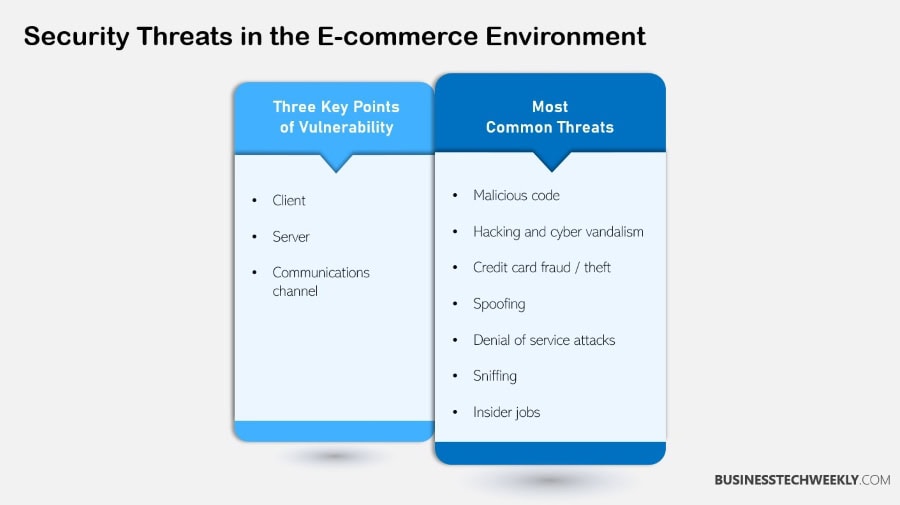
Privacy in Online Transactions
Securing sensitive customer data when making an online purchase should be a top priority.
Privacy policies, particularly those in line with regulations such as GDPR, reinforce positive expectations of your brand. Educating customers on how they can protect their personal information only deepens this trust.
Encryption technologies such as SSL are essential for protecting sensitive data in transit. They eliminate the vast majority of e-skimming and Magecart attacks.
Data Integrity and System Protection
Keeping customer data accurate and consistent across all channels is essential to keeping your brand credible.
Consistent data backups protect against loss during a cyber attack. Tracking systems for unauthorized modifications protects data integrity and can prevent data breaches and manipulation.
Techniques such as checksums and hashes ensure data integrity with every transfer, providing another measure of security.
User Authentication Techniques
Implementing stronger authentication measures such as two-factor authentication makes it more difficult for hackers to access sensitive information.
Staying ahead of emerging cyber threats starts with establishing up-to-date protocols.
By educating users on how to create strong passwords, you can prevent unauthorized access from the start.
Biometric authentication is more secure, protecting sensitive data with additional security layers.
Ensuring Non-repudiation
Digital signatures play a crucial role in combating common Ecommerce site security threats by ensuring the authenticity of each transaction, which eliminates chargeback disputes.
Keeping clear records of every transaction serves as an important accountability measure and a part of robust protection against ecommerce fraud.
Secure timestamping not only authenticates when a transaction occurred but also provides an indisputable record, enhancing ecommerce website security.
By educating users about non-repudiation, we contribute to a secure shopping experience, ultimately helping to safeguard customer data in the face of potential security breaches.
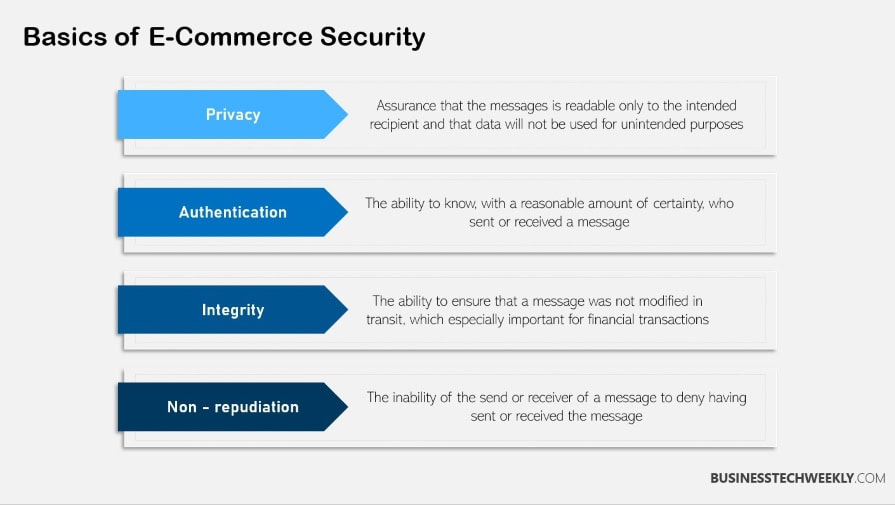
Common Cyber Threats to Ecommerce
Phishing and Social Engineering Dangers
Phishing and social engineering are ever-present threats to ecommerce platforms. These techniques usually deceive shoppers into exposing private information, resulting in costly information breaches.
Implementing advanced email filtering systems and regularly training employees to recognize suspicious communications are great first steps in mitigating these risks.
Whether through quarterly awareness campaigns or other ongoing initiatives, you can keep your customers informed about safe online practices.
This helps them to identify and avoid phishing attempts.
RELATED: 5 Types Of Phishing Attacks & How They Work
Risks of Malware and Ransomware
Malware and ransomware are critical threats to both online and offline businesses.
Doing so requires installing strong antivirus and antimalware software to protect all systems from sneaky, malicious attacks.
When systems are regularly updated, vulnerabilities are patched quickly, ensuring that they cannot be easily exploited by malware.
Staff education is essential to help them recognize potential threats. Additionally, having a response plan for ransomware incidents ensures preparedness.
RELATED: Types of malware businesses must protect against
SQL Injection and XSS Vulnerabilities
SQL injection and Cross-site Scripting (XSS) are common vulnerabilities across ecommerce platforms.
Regular security audits go a long way toward detecting and addressing these vulnerabilities.
Training developers on secure coding practices and utilizing web application firewalls are just two ways that ecommerce companies can begin to protect against these threats.
E-skimming and Magecart Threats
E-skimming attacks on checkout processes are on the rise. Regularly monitoring these processes and updating payment systems can go a long way to ensure no unauthorized code injections occur.
Educating customers on how to identify secure payment gateways is another layer of protection.
DDoS and Bot Attack Challenges
DDoS and bot attacks can make ecommerce services unavailable.
Deploying DDoS protection services and monitoring traffic patterns in advance goes a long way toward meeting these challenges head-on.
Applying rate limiting or other controls prevents the abuse of excessive requests and keeps your service running and available.
RELATED: Types of DDOS Attacks , What Are They & How Do They Work?
Brute Force and Account Takeover Risks
Brute force attacks and account takeovers put customer accounts at risk.
Enforcing strong password policies and implementing CAPTCHA can help mitigate these threats.
Educating users about how to spot account takeover is another layer of protection for their accounts.
Card-Not-Present Fraud Concerns
Card-not-present fraud is one of the biggest threats to ecommerce.
When paired with secure payment gateways and transaction monitoring tools, they can easily detect and even prevent suspicious activities.
Encouraging customers to use virtual cards adds another layer of security.
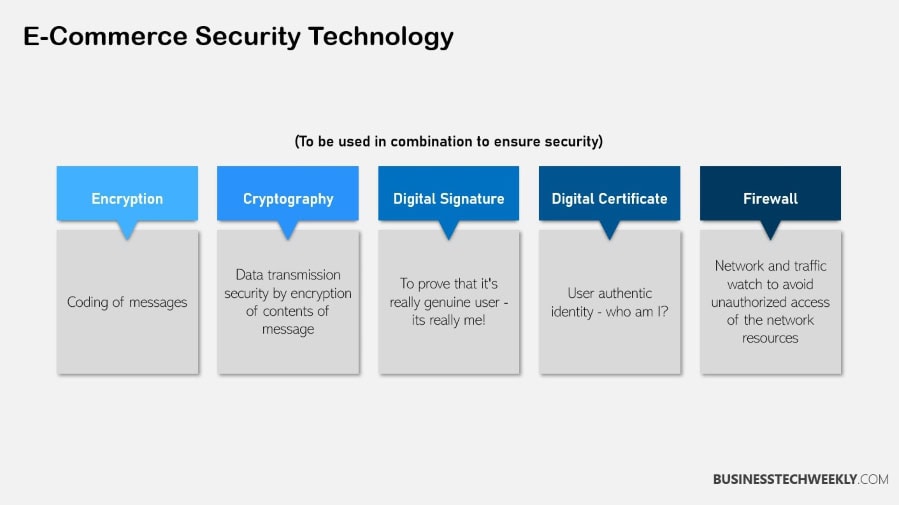
Managing Internal Security Threats
Developing clear, well-defined security policies are at the core of managing internal threats in the e-commerce realm.
These policies provide a structured approach to handling sensitive information, ensuring every team member knows the procedures and their importance.
Strict background checks on employees are imperative to ensuring that we can trust the people who hold the keys to sensitive data.
This thorough process allows you to scope out risks ahead of time, preventing them from evolving into threats.
Developing an organizational culture of security mindfulness is just as important.
Ongoing training on cybersecurity best practices helps to educate and empower all employees. They become the most important and first line of defense against these breaches.
Regularly reviewing access permissions ensures only authorized personnel can access sensitive information, reducing the chance of accidental or malicious exposure.
Addressing Employee Negligence
Regular cybersecurity training is essential to keep employees aware and on guard.
Enacting strong data usage policies establishes a baseline set of rules for how data should be handled.
Monitoring access to sensitive data helps identify negligent behavior, while encouraging incident reporting without fear promotes transparency and quick response.
Preventing Insider Sabotage
When sabotage occurs, regular audits can identify strange patterns of behavior that might indicate it’s taking place.
Cultivating a culture of reporting through a whistleblower policy and limiting system access based on role are ways to cut down on insider threats.
A supportive workplace culture reduces the incentive to sabotage.
Handling Third-party Access Issues
Vetting new vendors to ensure security practices have become common sense.
Contracts with third parties should specify security measures taken.
Contracts should undergo routine reviews of third-party access to help prevent breaches and protect sensitive information.
Improving Password Hygiene
Advocating for password managers helps to ensure people are using strong passwords.
Making these changes mandatory, along with educating users about the dangers of password reuse, makes us all more secure.
Promoting the use of passphrases for passwords provides an extra layer of defense.
Monitoring Data Access
Implementing ecommerce security measures such as logging systems to audit data activities, along with regular log reviews, can quickly identify attempts at unauthorized access and enhance website security against common ecommerce security threats.
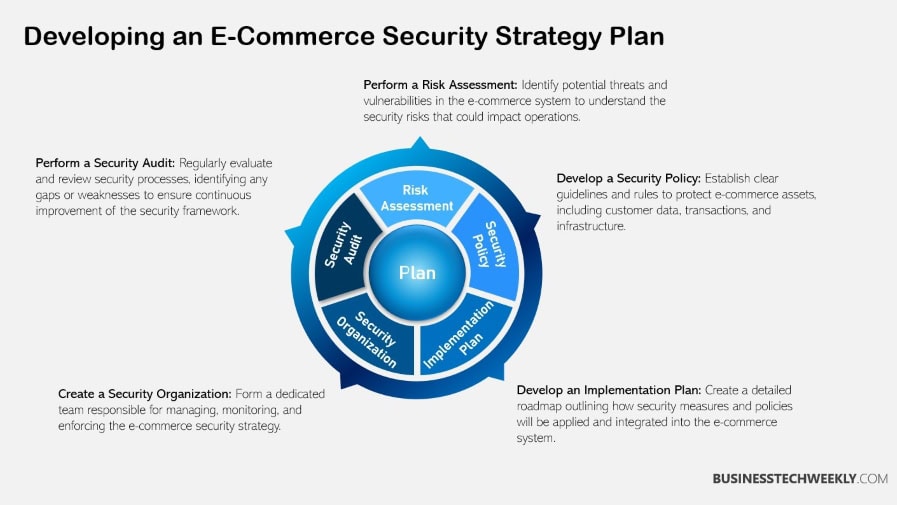
Best Practices for Ecommerce Site Security
As the ecommerce landscape continues to change exponentially, ensuring robust ecommerce site security practices should be a top priority.
To protect sensitive data and safeguard customer data, every single ecommerce business needs to implement several ecommerce security measures.
By following these practices, customers will feel more secure as they trust your brand.
- Leverage a combination of security solutions to defend against advanced threats.
- Regularly update software and systems to patch vulnerabilities promptly.
- Provide security awareness training for employees and your customers to help create a culture of security awareness.
- Implement strong authentication methods to secure access to accounts.
1. Establish a Robust Password Policy
Defining some best practices for creating and storing passwords should be a top priority.
Require minimum complexity standards to increase the difficulty of password cracking.
Make sure users understand the importance of changing passwords regularly.
Schedule regular audits to measure compliance and hold everyone accountable to these critical policies.
2. Limit Access to Sensitive Information
Role-based access controls must be implemented to limit data access.
Frequently audit user permissions to make sure they’re still warranted.
Teaching employees how to safeguard sensitive data and employing a data classification framework to help prioritize information is key to preserving data security.
3. Develop a Security Integration Plan
A robust security strategy should detail how security will be embraced throughout the organization—from implementing security practices into the dev lifecycle.
Commit all departments to this strategic plan, and revisit it frequently to adapt to new and evolving threats.
4. Choose a Secure Ecommerce Platform
When evaluating platforms, consider security features implemented within the platform and its compliance with standards, giving priority to platforms with security measures built in.
Read other ecommerce user reviews to gauge a platform’s reliability and look for platforms that offer regular updates and security patches.
5. Implement SSL Certificates
Obtaining SSL certificates encrypts data exchanged between users and servers, and show security badges to help improve customers’ trust.
Renew certificates on a regular basis. Ensure all connections to your site are always secure and teach customers to look for HTTPS in your URL.
6. Apply Two-Factor Authentication
Turning on two-factor authentication adds an extra layer of protection to your account. Help users configure and incentivize them to use your app instead of SMS to provide more security.
Monitor these methods closely to ensure their effectiveness.
7. Regularly Update Software and Systems
Establish a routine process for updating software and systems. Regularly patch known vulnerabilities.
Consider automated tools to help manage them effectively and conduct training to ensure staff understand the need to remain current.
8. Train Staff on Security Protocols
Implementing an ecommerce cybersecurity training program is essential for ecommerce business owners.
Hold monthly meetings to engage your staff in practices and drills, ensuring readiness against common ecommerce security threats.
9. Develop an Incident Response Strategy
Developing a thorough breach response plan is essential.
Clearly assign roles for swift response, conduct drills to test the plan, and revise the plan based on lessons learned to enhance future response efforts.
10. Conduct Regular Security Audits
Schedule periodic audits to evaluate security measures. Use external auditors for unbiased assessments, document findings, and implement improvements.
Establish a timeline for follow-up audits to ensure ongoing compliance.
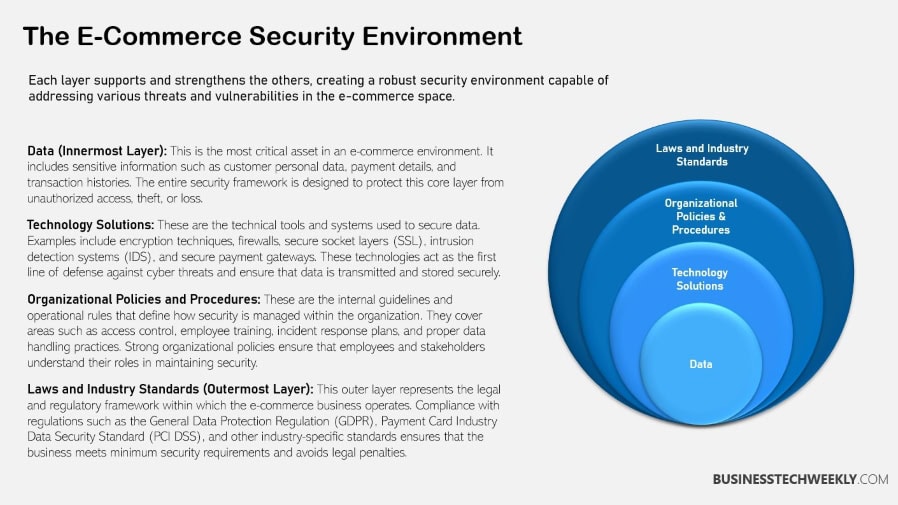
Compliance and Legal Considerations
Beyond the technical aspects, ecommerce websites are faced with a gauntlet of compliance and legal considerations, all in a bid to mitigate ecommerce site security threats and ensure a secure shopping experience.
Here’s a quick glance at the critical areas you should focus on.
- If you’re processing payments ensure your are PCI compliant to keep transactions safe.
- Ensure GDPR Compliance to protect customer data.
- Familiarize with CCPA Guidelines to uphold consumer privacy rights.
- Pursue ISO/IEC Certifications for adhering to international standards.
RELATED: Compliance vs Information Security: Which Should Your Business Prioritize?
Understanding PCI-DSS Standards
Get a basic knowledge of Payment Card Industry Data Security Standards (PCI-DSS). This understanding is key to preventing compromise of cardholder data.
Taking these security measures is a big step towards avoiding data breaches. Ongoing audits are important to maintain compliance.
By educating your staff about these new standards, you ensure that everyone has the same understanding and expectations moving forward.
Beyond that, BigCommerce is a PCI DSS Level 1 Service Provider, the highest security standard available in the industry.
GDPR Compliance Essentials
The General Data Protection Regulation (GDPR) is the foundational law governing customer data privacy within the EU.
You must get clear customer consent before you collect data from them and provide customers a way to view, update, or delete their data.
Staying on top of your compliance is the best way to avoid big penalties. These penalties can be as high as $21 million or 4% of your annual global revenue—yikes!
CCPA Guidelines for Ecommerce
Having an understanding of the California Consumer Privacy Act (CCPA) is essential for any business that operates in California today.
You need to make it easy for customers to request their data and understand how you use their data.
Privacy policy compliance is crucial. Frequent updates to privacy policies are needed in order to stay compliant with rapidly changing regulations.
ISO/IEC Certifications Overview
ISO/IEC 27001 certifications are key for proving your organization’s commitment to information security management.
These rigorous certifications increase transparency and accountability.
Integrating the best practices of these standards sets in place strong security protocols. Routine compliance reviews are necessary to uphold these certifications.
Enhancing Ecommerce Site Security Strategies
To fortify your ecommerce website, consider these ecommerce security measures.
- Implement multi-factor authentication (MFA).
- Conduct regular security assessments.
- Stay updated on emerging cybersecurity threats.
- Foster a culture of security awareness among employees.
Implement Multi-Factor Authentication
Prompting multi-factor authentication (MFA) on all user accounts is a simple yet effective way to make your ecommerce site security more secure.
It brings a new layer of security that makes it immensely harder for someone to access your account without permission.
By explaining the benefits of MFA to users, you can improve their comprehension and buy-in.
Continuously monitoring the effectiveness of your authentication methods helps to make sure that they stay strong in the face of new threats.
Information and assistance for users during MFA installation will make the process smoother and increase adoption rates.
Importance of Regular Security Assessments
Scheduling regular security assessments helps identify vulnerabilities before they become critical issues.
These assessments offer insights to refine security measures and protocols, ensuring your defenses remain strong.
Educating staff on the importance of these assessments fosters a proactive security culture within your organization.
Staying informed about new threats allows you to adjust your assessment focus, addressing potential risks promptly.
RELATED: How to perform a cybersecurity risk assessment
Key Points to Remember
Ecommerce security is your first line of defense for your online business.
Protecting your site from external threats is keeping your customers’ trust – and repeat customers – in your hands.
By understanding prevalent cyber threats and mitigating internal vulnerabilities, you create a more secure experience for your shoppers.
- Ecommerce site security is essential in protecting online transactions and sensitive customer information. It provides assurance to customers, guards against unauthorized access, and mitigates data breaches. That is why a holistic, multi-layered security strategy is critical for businesses operating in this highly competitive landscape.
- Implementing privacy policies that comply with regulations and using encryption methods are vital to safeguarding customer information during online transactions, which enhances trust and security.
- We ensure data integrity and safeguard our systems by using frequent backups. In addition, we track unauthorized changes and perform checksums and hashes to ensure the integrity of data in transit.
- Strong user authentication methods are critical for improving security. They block unwanted invaders with features such as two-factor authentication and biometric authentication. Regular development of these protocols is essential to combat changing cyber threats.
- Phishing, malware, and DDoS attacks are some of the most common cyber threats. To protect against these risks, minimize threats by proactive risk management including informing customers, updating systems regularly, and using security tools including firewalls and antivirus programs.
- Ecommerce businesses are obligated by legal standards such as PCI-DSS, GDPR, and CCPA to protect consumer data and face serious penalties if they do not. Maintaining this compliance takes a deep knowledge of these regulations and continuous testing to confirm compliance is being met.

